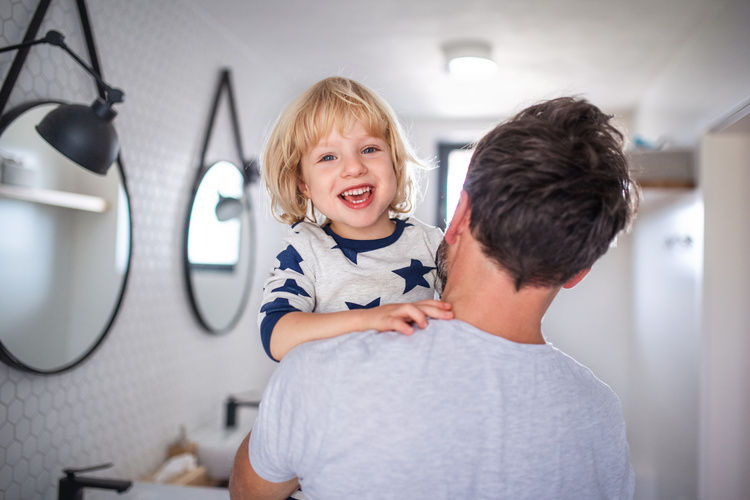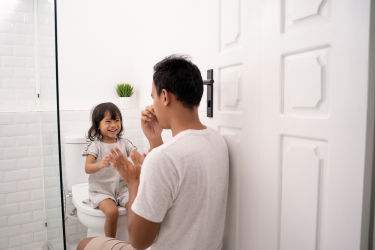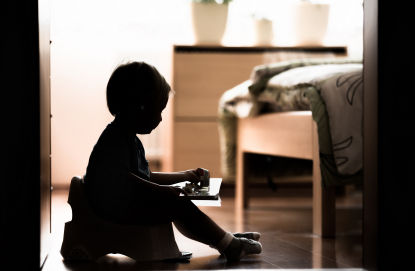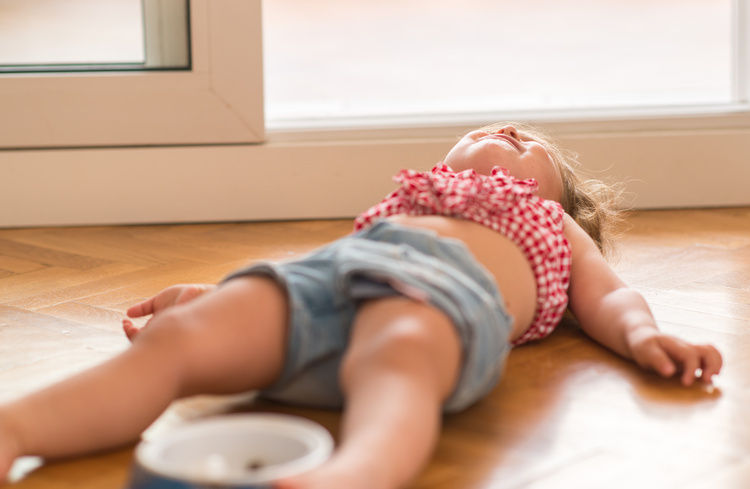How to Prepare for Toilet Training a Toddler
Is your little one ready to master the big skill of using a toilet?
Congratulations! Toilet training a toddler is a huge milestone for many families and getting your child to use the toilet confidently is a big step in their development and growth. Toilet training can come with many ups and downs as you navigate emotions from yourself and your little one.
This is new territory for first-time parents, and sometimes it's hard to know when, where and how to start. In this article, we’re diving into everything to do with mastering the toilet, including knowing when to begin, products that might be helpful along the way and some tips for success on this new journey for you and your child.
Is your child ready for toilet training?

The first step to toilet mastery is determining if your child is ready to use the toilet. Every child is different, and some may be ready earlier than others. Waiting for the signs your toddler is ready can save time and effort in the long run, as well as help to make the experience positive for the whole family.
You might notice signs of readiness anywhere from 18 months old through to 3 years old, although, some children may show signs earlier or later than this range. Some indicators that your little one is ready include:
• Dry nappy for up to two hours.
• Can walk and sit for short periods of time.
• Can communicate with words, actions or noises before they are doing a wee or poo in their nappy.
• Begins to dislike wearing a nappy, particularly when they become full or dirty.
• Can pull their pants up or down.
• Shows an interest in the bathroom and when others use the toilet.
Although these are some general signs, it’s best to listen to your toddler, observe their behaviour around the subject and let them set the pace for when to start potty training.
Helpful items for toilet training
Once your child starts showing signs that they are ready for toilet training, the next step is to get prepared. We’ve compiled a list of items that you’ll likely need to make this process as smooth as possible for both you and your toddler.
1. Potty
Children usually start toilet training either using a potty or the toilet. If you have chosen to use a potty first, this can be used before your baby shows signs of wanting to use the toilet. A potty can be placed in the nursery or playroom and can help get your toddler familiar with sitting on it. While they play, you can talk to them about the potty, what it is and why they should use it. This will help build their confidence before they start training.
2. Toilet
Some people choose not to use a potty at all, and this is also fine! Starting out with the regular toilet works well for many children, so it’s all about personal preference. If you’re using the normal toilet, you might want to use a smaller toilet seat with a step so your little one can access the toilet and feel supported and secure enough to relax their body.
Alternatively, you can also get a specialised toilet seat that has an adult seat and a child seat that you simply flip between depending on who is using it. Another option if you’re physically able and willing is to support your little one while they use the toilet each time, though this can be tricky if you’re encouraging them to use the toilet independently or you’re busy with other tasks.
Kids toilet seats like the Roger Armstrong Ultimate Toilet Trainer are designed with a step and potty seat all-in-one that can be placed on the adult toilet seat and give children the confidence to use the ‘big toilet’ while supporting their little bodies.
3. Training Pants
Training pants are great for getting your little one used to the sensation of ‘wetness,’ as they are not very absorbent, so when your child does a wee or a poo, they will not feel as comfortable as they usually do with a nappy.
Training pants can also help children notice their body signs for when they need to go. They might start to take more notice of having a full bladder and what that feels like. As time goes on and they feel more uncomfortable, they will begin to tell you when a change is needed or show more interest in using the toilet when they feel the need to go.
4. Waterproof Mattress Protector or Underlay
It’s recommended that you use nappies for night time. However, if you have chosen not to put nappies on your child during the night, then investing in a waterproof mattress protector or underlay will help to maintain the hygiene of their mattress in case of any accidents. In the morning, remove the fitted sheet and mattress protector to be washed.
5. Toilet Training Picture Books
If your child loves being read to, as many do, then reading them a book about toilet training can help them better understand the process. Reading a fun or entertaining story about a character learning to use the toilet can help toddlers visually see themselves using the toilet. Reading a story like this in a calm environment, like in their bed or toy room can help children not feel too overwhelmed and can even help them feel excited about the process.
Toilet training impacts the whole family unit and consistency is important for success, so if you have a parenting partner, make sure you include them and try to get on the same page before getting started.
How to prepare your child for toilet training

Once your home and your child are ready, there are a few extra things you can do to help them feel prepared.
1. Underwear shopping
As a first step, take your child underwear shopping. Allowing them to pick out some fun underwear, with their favourite colour, cartoon characters or images can help children get excited to wear them.
2. Decide on a weekend
It’s best to start on a weekend or a long weekend without many activities happening. As toilet training is a big change for your little one, staying at home and going about your regular routine without much distraction is the best way to keep your toddler from feeling overwhelmed.
Before the weekend you intend to start, begin to talk to your child about saying goodbye to their nappies, why they are going and that they will start to be a ‘big kid’ from now on and use the toilet/potty to go.
3. Show and tell
Start to involve your toddler when your use the bathroom and the toilet. Invite them into the room while you go whenever possible, talking through the process, using verbal cues as you go so they can draw the link when they start the process, getting them to push the flush button and wash their hands with you each time. A visual demonstration from a trusted and loved parent or older sibling can help to normalise the experience and give toddlers the confidence to be comfortable around the toilet, especially if they are nervous about the flush or the toilet seat.
Tips for Toilet Training

While there are many ways to go about toilet training, the process should be specific to each child, their needs and how they respond to the process:
• Start by giving your toddler a big cup of water straight away when they wake up. While they would have already used their nappy by the time they wake up, this will help to stimulate their body’s digestive system for the rest of the day.
• Try to check in with your little one regularly to help them monitor their body and what they’re feeling. Asking questions like, “how is your body feeling?” or “Does your tummy feel like doing a wee or a poo?” can help children t start to connect to their bodies more.
• Use encouraging words and phrases to get them to go to the toilet when they show signs like wriggling around, passing wind, becoming quiet or moving away from you. For example, “do you want me to help you go to the toilet?”, or “do you feel like going to the toilet?” can help children evaluate their bodies and understand their feelings.
• Check in with your child regularly about connecting with their body and any urges they may have, especially when they change activities like when they go from playing to lunchtime.
• When your child wants to go, sit them on the toilet, and let them leave when they are ready. Forcing them to stay on the toilet for an arbitrary amount of time can cause anxiety around toileting, and they know their body best. Straining to go can cause other damage to their muscles and is unnecessary.
• Remember that this is you and your child learning to master a new skill together, not you ‘training’ someone into compliance. You’re a team, and your child won’t have accidents or make a mess simply to spite you. If they do have an accident, play it cool, remind them they aren’t wearing a nappy and ask if they need to finish off their wee or poo on the toilet.
Depending on your toddler’s personality, you could ask them to assist you with clean-up, by passing paper towels or spraying disinfectant on the area – but some toddlers are more likely to want to play in the mess, so listen to your gut about your toddler’s temperament when it comes time to clean up!
Dressing your child for toilet training
Choose your little one’s clothes carefully when you’re helping them use the toilet. Avoid clothes that are hard to get on and off quickly, avoid too many layers, and avoid clothes that mimic the feeling of a nappy.
In fact, you may even want to avoid undies for the first day or two – while your toddler is busy playing away, anything that tricks their mind into thinking they have a nappy on as they always have can contribute to accidents. If they do have an accident, being able to actually see what has come out of their body can help connect the feeling with the action for some children.
Keeping your child clean and hygienic
Keeping your child clean and dry during the process will help them to feel good about going to the bathroom. Learning how to control their body’s natural tendencies properly and when to excrete them can be a very vulnerable time for your little one, so make sure that when cleaning and wiping, to stay calm and use a gentle tone when speaking. This will help children not think that going to the bathroom is a punishment but an easy experience.
• Once your child has finished their business on the toilet or potty, wipe their bottom until they can do it themselves. Make sure to wipe from front to back, especially for girls. If they resist you wiping them, empower them to have a go themselves and either guide their hand, practice taking turns, or they do it and then you ‘check’ for anything leftover.
• When toilet training boys, you can place a ping pong ball in the toilet to help them aim, and once they’ve finished their wee, teach them to shake afterwards to remove any excess urine. Some kids or parents prefer to begin by sitting them on the toilet or potty to go, which can get a little messy. In this case, show them how to tuck everything so it’s facing down into the toilet or potty and have plenty of baby wipes handy to clean up quickly afterwards.
• Washing their hands after they have used the toilet or potty is an important skill. Show them how to wash their hands using soap and water and wash for 20 seconds.
What to do if you’re out?
While toilet training, you may want to stay at home for a few weekends until your little one feels comfortable using the toilet and recognising their body signals. However, you can’t stay at home forever. So, what do you do when out and about?
1. Recognise that there will probably be one or two accidents. Introducing a new environment that your child isn’t used to, in addition to the excitement of going somewhere, can distract your toddler from noticing their body signs.
2. Make sure to pack a few extra outfits when going out, along with a waterproof or plastic bag to carry dirty clothing if they need to change.
3. Try taking your toddler out and about without a nappy on a day where you can go straight home if they have an accident. If something does happen, support them through what might be an embarrassing experience, using gentle and encouraging language.
Night Toileting
Bedwetting is a common occurrence while toilet training. Generally, between the ages of three and eight years old, there is a hormone that starts to be released, known as Anti-Diuretic Hormone (ADH), that reduces urine output through the night. However, some children might not produce enough of this hormone, which can cause little accidents
Given overnight dryness is developmental, it's not something that can be forced onto your toddler. So if you're set on ditching nappies, then you'll probably want to invest in 2-3 mattress protectors. Look to 'double make' their bed (protector, bottom sheet, protector, bottom sheet) for quick overnight changes.
Other tips include taking your little one to the toilet before bedtime to empty their bladder. That way, your little one can try and make it partway or almost completely through the night without wetting the bed.
Potential setbacks while toilet training

Although toilet training is a monumental step for your child’s development, that doesn’t mean there won’t be some challenges along the way. Your toddler is learning something new, and it might not be very comfortable or pleasant at first, which may lead to some setbacks throughout the process. Importantly, if you’re noticing lots of setbacks, or your little one is struggling, there’s no shame in putting toilet training on hold and waiting a few more months to have another go when they might be more ready.
My Child Doesn’t Want to Poo in The Toilet
Sometimes training for poos takes longer than training for wees. Some children who can use the toilet for wees will refuse to poo in the toilet or run away/hide when they need to poo. Causes and solutions for this can include:
• Shyness: Pooing in front of someone else can be more confronting than weeing. Maybe your little one is uncomfortable being watched. Try giving them some privacy and letting them know to call out when they’re done or if they need you.
• Used to standing up: Once kids start walking around, they can grow accustomed to pooing in a more upright position. If you think your toddler may need to poo, try putting them on the potty in their nappy. This might be less of a shock to their system and will get them used to the sitting position.
• Scared of falling in: Some children are too little for adult toilet seats! If you haven’t already, purchase a fitted toilet training seat that goes over the standard seat to help them get accustomed to the toilet seat.
• Uncertainty: Children can be reluctant to let go of their poo because they don’t fully understand it is ‘waste’. Try explaining how poo is made and what it is, or ‘waving goodbye’ as you flush it away.
• The flush sound is scary: Let your toddler leave the room before you flush the toilet.
• Constipation: Constipation can be painful and make a child reluctant to go to the toilet. Make sure to include plenty of fibre, fruit and vegetables in their diet. Talk to your doctor or pharmacist if they seem to be constipated.
Toilet training regressions
Your child is toilet trained, you’re in the clear, and then… back to square one. Sometimes toilet-trained children regress, and will ask to go back to nappies, or will have more accidents. Patience is key in this situation.
Get curious and see if there is an underlying cause for the setback. Have you recently moved house, changed daycare centres, or welcomed a sibling? Did your little one have a scary experience with the toilet, perhaps with an extended family member? Looking at the world through your toddler’s eyes can help you connect with them and understand their reluctance to use the toilet or potty, so you can troubleshoot challenges together as a team.
How to deal with toilet training accidents
Whether your child is regressing or not, they may have some accidents even after a period of seeming toilet trained. Avoid shaming or guilting them in this situation. Use positive language and encourage them to keep trying.
Mastering the toilet is an exciting milestone – especially when you can walk straight past the nappy aisle at the shops. Approaching toilet training with kindness, compassion, patience and ensuring your little one is truly ready before getting started can help make sure the experience is pleasant for the whole family.
Discover our selection of toilet training essentials from Baby Bunting, including changing essentials, manchester and more.